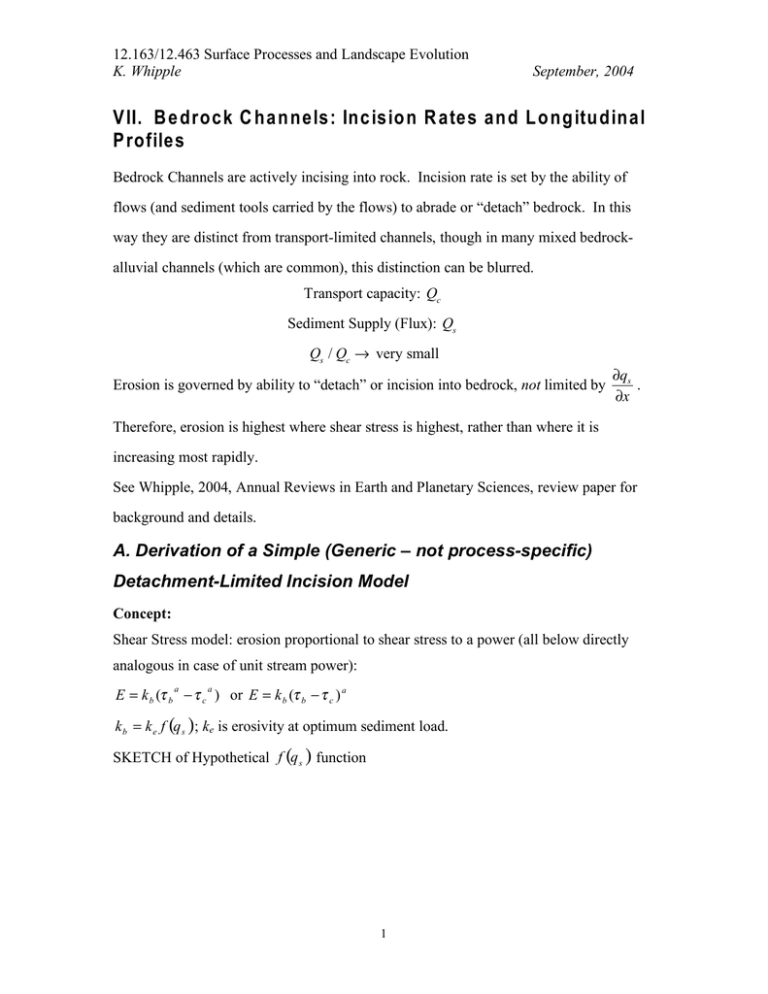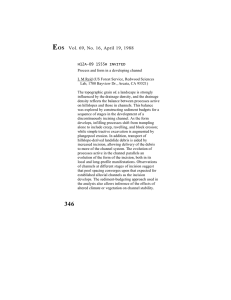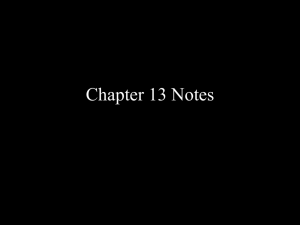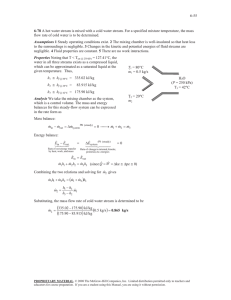VII. Bedrock Channels: Incision Rates and Longitudinal Profiles
advertisement

12.163/12.463 Surface Processes and Landscape Evolution K. Whipple September, 2004 VII. Bedrock Channels: Incision Rates and Longitudinal Profiles Bedrock Channels are actively incising into rock. Incision rate is set by the ability of flows (and sediment tools carried by the flows) to abrade or “detach” bedrock. In this way they are distinct from transport-limited channels, though in many mixed bedrockalluvial channels (which are common), this distinction can be blurred. Transport capacity: Qc Sediment Supply (Flux): Qs Qs / Qc ! very small Erosion is governed by ability to “detach” or incision into bedrock, not limited by !qs . !x Therefore, erosion is highest where shear stress is highest, rather than where it is increasing most rapidly. See Whipple, 2004, Annual Reviews in Earth and Planetary Sciences, review paper for background and details. A. Derivation of a Simple (Generic – not process-specific) Detachment-Limited Incision Model Concept: Shear Stress model: erosion proportional to shear stress to a power (all below directly analogous in case of unit stream power): E = k b (! b " ! c ) or E = k b (! b " ! c ) a a a k b = k e f (q s ); ke is erosivity at optimum sediment load. SKETCH of Hypothetical f (q s ) function 1 12.163/12.463 Surface Processes and Landscape Evolution K. Whipple September, 2004 Conservation of Mass (water): Q = u hW Conservation of Momentum (steady uniform flow): " b = !ghS " b = !C f u 2 Goal: write τb in terms of slope, discharge. Use conservation of mass (water), substitute into friction relation: # b = "C f Q 2 (Wh ) !2 Solve shear stress equation for flow depth, substitute into above gives: # b = " 3 g 2 C f Q 2 (W ) S 2 !2 3 " b = !g 2 3 C f 13 (Q W )2 3 S 2 3 Can be written as: # b = kt (Q W ) S ! " where k t = "g ! C f ! 2 ; ! = 23 , ! = 2 3 (Generalized Darcy-Weisbach friction relation); ! = 53 , ! = 107 (Manning) Channel Width Closure Empirical relation for hydraulic geometry (channel width closure used if direct measurements of W not available): W = k w Q b ; b ~ 0.5 typical in both alluvial and bedrock rivers. Substitute into relation for shear stress: 2 12.163/12.463 Surface Processes and Landscape Evolution K. Whipple September, 2004 # b = k t k w Q " (1$b )S ! $" Drainage Basin Hydrology For application to ungauged rivers, use empirical relation for basin hydrology: Q = k q Ac 0.7 ≤ c ≤ 1.0 typical (c < 1 reflects: storm size < basin size, short storm duration, nonuniform ppt, groundwater losses, storage in floodplains, etc) Combine Above to Derive the Stream Power Incision Model Substitute into relation for shear stress: $" # b = kt k w k q " (1$b ) A"c (1$b )S ! Combine these for case ! c << ! b in floods of interest E = k e f (q s )! b gives the wella known “Stream Power River Incision Model”: E = KA m S n n = !a ; m = "ac(1 ! b) K = k e f (q s )k w !" a kq "a (1!b ) kt a m # " = c(1 ! b) ; = 1 for Generalized Darcy-Weisbach friction relation n " ! m/n ~ 0.5 characteristic of broad range of fluvial incision processes that scale with shear stress (or unit stream power) raise to some power (a). If erosion process is linear in shear stress (a = 1), expected exponents in the stream power incision model are: m ~ 1/3, n ~ 2/3. Empirical Field Support Howard and Kerby, 1983, GSA Bulletin: Empirical study of river incision into weak rocks in badlands over ~20 years. dz = 0.11A.44 S .68 ; R2 = .85 (50 data points) dt 95% confidence intervals: 0.06 < K < .21; .38 < m < .51; .58 < n < .78 Why Stream Power? What is Stream Power? Unit Stream Power? 3 12.163/12.463 Surface Processes and Landscape Evolution K. Whipple September, 2004 Both bedrock channel incision and sediment transport have also been proposed to scale with the rate of potential energy expenditure per unit bed area (the so-called “unit stream power”, ω): E = k b! a Stream power is the rate of potential energy expenditure per unit length of channel. Difference in potential energy between points along a stream is: !Pe = "Vg!z So rate of change of Pe per unit channel length (Δx) is: "Pe #Vg"z "z = = #gQ = #gQS = ! "t"x "t"x "x where we have noted that Q = V !t and Ω is used for Stream power per unit length. Stream power per unit bed area (ω) is thus: "= # !gQS = W W Unit stream power can in fact be directly related to shear stress: #= "gQS "gu hWS = = "ghSu = ! b u W W Also, recall that average velocity is directly related to bed shear stress: " b = !C f u 2 or u = "b !C f Thus we have: # = " bu = "b 32 !C f = !gQS W Therefore, an erosion rule that erosion is a power function of unit stream power can be written, using the hydraulic geometry and basin hydrology from above as: E = k b! a E = KA m S n n = a ; m = ac(1 ! b) K = k e f (q s )k w k q "a a (1"b ) !aga 4 12.163/12.463 Surface Processes and Landscape Evolution K. Whipple September, 2004 m = c(1 ! b) n As before, m/n ~ 0.5. If erosion process is linear in unit stream power (a = 1), expected exponents in the stream power incision model are: m ~ 1/2, n ~ 1. Thus in conclusion, erosion linear in unit stream power is essentially identical to erosion proportional to shear stress raised to the 3/2 power; in other words the difference is all in the value of the exponent a in the basic postulate: E = k e f (q s )! b . a B. Conservation of Mass (Rock): Profile Evolution Now we can consider conservation of mass of the rock to write an evolution equation for a bedrock channel: "z = U ! E = U ! KA m S n "t At steady state, U = E such that !z = 0 , such that we can write: !t U = KA m S n this can be solved directly for the steady-state river slope: 1 m 'U $n ! S =% " A n &K# Thus a power-law relation between local channel slope and upstream drainage area is predicted: a straight line in plot of logS vs. logA with slope –m/n (concavity index) and intercept (U/K)1/n (steepness index) (this is true only if U, K, m, and n are spatially uniform … what might happen to profile concavity where K = K(qs) = K(x)?) Steady-State Longitudinal Channel Profile By integrating the above relation we can derive an equation for the longitudinal profile of the river at steady state: 1 (z 'U $n ! ! =S =% " A n (x &K# m 5 12.163/12.463 Surface Processes and Landscape Evolution K. Whipple September, 2004 To integrate we need to write A in terms of along-stream distance, x. A robust empirical relation known as Hack’s law (Hack, 1957) allows this: A = k a x h ; where ka ~ 6.7 and h ~ 1.67 are typical values. Substituting in and setting up to integrate both sides: 1 )z ( U % n !m ! " )x = !" &' K #$ k a n x n hm 1 '1 & hm # hm & U # n ' m & hm # $% 1' n !" z (x ) = '$ ! k a n $1 ' +C ; !1 ! x n " n %K" % 1 hm & U # n 'm z (x ) = '$ ! k a n ln (x )+ C ; =1 n %K" To find constant of integration, set baselevel z = z(L) at x = L 1 '1 & hm # & U # n ' m & hm # $% 1' n !" z (L ) = '$ ! k a n $1 ' +C ! L n " %K" % 1 - U * n ' m - hm * z (x ) = + ( k a n +1 ' ( n ) ,K) , '1 * - hm * & -+ 1' hm ( + 1' (# hm n ) n ) , , L ' x ! 1 ; xc ! x ! L $ ! + z (L ) ; n $% !" 1 hm ' U $ n !m z (x ) = % " k a n [ln (L )! ln (x )]+ z (L ) ; = 1 ; xc ! x ! L n &K# where xc (~ 200-1000m typical) is the distance from the divide at which fluvial processes become dominant over hillslope processes (soil creep, landslides, etc) and debris flow scour. Fluvial Relief of Drainage Basins Fluvial Relief is thus given by: 1 - U * n ' m - hm * R f = z (xc )' z (L ) = + ( k a n +1 ' ( n ) ,K) , 1 '1 - hm * & -+ 1' hm *( + 1' (# hm n ) , ' xc, n ) ! ; !1 $L n $% !" hm ' U $ n !m R f = z (xc )! z (L ) = % " k a n [ln (L )! ln (xc )] ; =1 n &K# 6 12.163/12.463 Surface Processes and Landscape Evolution K. Whipple September, 2004 Note that all except U, K are geometrical variables, so convenient to simplify to: 1 &U #n R f = z (xc )' z (L ) = ( $ ! %K" where β is expected to vary weakly with tectonic, lithologic, and climatic conditions and is given by: '1 - hm * & -+ 1' hm *( + 1' (# hm n ) , ' xc, n ) ! ; !1 $L n $% !" . = ka ' m n - hm * +1 ' ( n ) , " = ka ! m n [ln(L )! ln(xc )] ; hm =1 n Channel Profiles and Fluvial Relief – Empirical Geometric Constraints The above all derived for steady-state conditions where bedrock channel incision is described by the stream power model and U, K, m, and n are uniform in space (same tectonics, climate, lithology, and erosion process) – a fairly restrictive set of assumptions. However, it is commonly observed that river profiles follow a power-law relation between channel gradient and upstream drainage area: S = k s A "! where ks is the steepness index and θ is the concavity index. Thus the above derivations for profile form and fluvial relief can be repeated for channels with this empirically observed form, yielding equivalent relations that are not directly tied to the above list of assumptions, ie. these relations are valid even if the stream power river incision model is not: z (x ) = k s k a !" (1 ! h" )!1 [L(1!h" ) ! x (1!h" ) ]+ z (L ) z (x ) = k s k a !" [ln(L )! ln(x )]+ z (L ) 7 ; h" ! 1 ; xc ! x ! L ; h! = 1 ; xc ! x ! L 12.163/12.463 Surface Processes and Landscape Evolution K. Whipple September, 2004 R f = z (xc )" z (L ) = !k s " = ka #! (1 # h! )#1 [L(1#h! ) # xc(1#h! ) ] # = ka !" [ln(L )! ln(xc )] ; h" ! 1 ; h! = 1 C. River Incision Processes Powerpoint Presentation: Physical Erosion Processes; plus lecture on constraints on how erosion processes scale with mean bed shear stress (ie. what is exponent a for different processes?) Topics Discussed During Presentation River Incision into Bedrock: • Interaction of a suite of process o Plucking, Abrasion (bedrock & suspended load), Cavitation (?), Weathering • Vortices shed off macro-roughness drive processes o Relation to mean bed shear stress? • Critical stress for incision/flood frequency • Adjustment of channel morphology/bed state • How non-linear? Relation to Climate? D. Weaknesses of the Stream Power River Incision Model • Neglects critical shear stress for incision (assumed exceeded in floods of interest) • Exponent a and kb unknown and depend on process(es) active • kb should depend on sediment flux – details uncertain • assumes steady, uniform flow, but much erosion may be related to knickpoints and local flow accelerations – at what scale should S be measured? • Roughness assumed constant in space (and with flow depth) 8 12.163/12.463 Surface Processes and Landscape Evolution K. Whipple September, 2004 • No model for channel width, just assumed to follow hydraulic geometry • No explicit treatment of flood frequency • Basin hydrology (Q ~ Ac) best for moderate floods. Extreme events can be pointsource events • Small angle approximation breaks down in steep mountain channels and on knickpoints (but minor in comparison to other concerns) E. Transient Profile Form and Landscape Response Time (time to steady state) Consider response of landscape starting at an initial steady state and subjected to a sudden step-function change in either rock uplift rate (U) or climate (K). Transient profile consists of two sections separated by an abrupt change in slope – a knickpoint. Downstream of the knickpoint the channel profile is adjusted to the new conditions (steady state with Uf and/or Kf); upstream of the knickpoint the channel profile reflects the old steady-state conditions (steady state with Ui and/or Ki). The profile reaches steady state when the lower segment reaches x = xc, or when: z (xc ) = z f (xc ) Time to steady state is given by the ratio of the total change in elevation at x = xc to the rate of change of elevation at x = xc: T= distance z f (x c )" z i (x c ) = velocity !z (x c ) !t We have from above that at steady state: &U zi (xc ) = ' $$ i % Ki . = ka ' m n " = ka ! m n 1 #n !! " &U f ; z f (xc ) = ' $ $K % f 1 #n ! ! " '1 - hm * - hm * + 1' (# hm - hm * & +, 1' n () ' xc, n ) ! ; !1 +1 ' ( $L n ) %$ n , "! [ln(L )! ln(xc )] ; hm =1 n Further, we can deduce from the transient profile form that: 9 12.163/12.463 Surface Processes and Landscape Evolution K. Whipple September, 2004 "z (xc ) "t = const = U f ! Ei (K f K i )= U f ! U i (K f K i ) for a change in U only, Kf/Ki = 1; for a change in K only, Uf = Ui = U Thus, defining the fractional change in uplift and the coefficient of erosion as: fU = U f U i ; f K = K f K i we may write the rate of change of elevation at x = xc as: "z (xc ) "t = U i ( fU ! 1) for a change in U only "z (xc ) "t = U (1 ! f K ) for a change in K only Thus system response time is given simply by: !1 n 1 1 !1 )K U i n '% fU n ! 1$" z f (xc )! zi (xc ) & # TU = = ( fU ! 1) (z (xc ) (t TK = z f (xc )! zi (xc ) (z (xc ) (t !1 n = 1 !1 n ' !n1 $ % f K ! 1" & # (1 ! f K ) )K i U Assumptions: • x c ! f (U , K ); L >> x c β = constant • Si = ksi A!" , S f = ks f A!" (concavity invariant, ks function of uplift rate) o For stream power model, ksi = ( 1 1 U U n ) , ks f = ( ) n Kf Ki • Slope is unchanged above knickpoint Retain sharp knickpoint ! no information is passed upstream TU 1Ma (order of) Vertical Knickpoint Velocity Objective: Use the solution for response time above to solve for vertical knickpoint velocity. Key: knickpoint travels (in z) from the basin outlet to the final position of the 10 12.163/12.463 Surface Processes and Landscape Evolution K. Whipple September, 2004 fluvial channel head … over the full distance of the new steady-state fluvial relief, in the same total amount of time. Set this definition of response time equal to the one derived above (they are two ways to express the same thing): # TU = 1 n 1 n 1 n !z knick z(xc ) f " K (U f #U i ) = = Vkp Vkp U f #U i " 1 1 z(xc ) f = ! K nU f n Solve for knickpoint velocity: Vkp = 1 n U f (U f !U i ) 1 n U f !U i 1 n = 1 n fU U i ( fU !1) 1 fU n !1 where fU = U f / U i thus, Vkp = U f when n = 1 • transient, U goes up, K goes down ! knickpoint moves upstream at constant vertical rate (all lie on the same contour within a basin!) • ! lithology ! fixed knickpoint • ! uplift (across a fault) ! fixed knickpoint Powerpoint Presentation: Distinctive Transient Behavior of Detachment-Limited and Transport-Limited Models. F. Advanced Topics: Process-Specific Abrasion Model; Critical Shear Stress and Flood Frequency Distributions Bedload Abrasion (saltation) Plane Bed (smooth): 11 12.163/12.463 Surface Processes and Landscape Evolution K. Whipple September, 2004 Sklar and Dietrich, 2004, WRR E = Vi I r Fe Q Q wsi 2 , I r ! s , Fe = (1 ! s ) Vi ! WLs Qc "v where Qs is sediment flux (supply), Qc is transport capacity and Fe is fraction exposed bedrock. wsi 2Qs Q E= (1 " s ) 2! vWLs Qc Ls ,Qs ,Qc = f (! b ) Q s = ! g AU where βg is the fraction of sediment that is bedload. Abrasion by Suspended Load: Eas = Sa qke !r where !r is rock density, Sa is abrasion susceptibility ( ! v ), and qke is the kinetic energy flux of particles impacting the bed. qke = 1 !r cvu p 2 " u p # u p 3 # uw 3 ; where up is the particle velocity. 2 Suspended transport: cv ! uw 2 , qke ! uw 5 , Ea ! uw 5 ! " b 5 /2 , a # 5 / 2 5 2 2 5 We can expect: 1 ! a ! , n = a, ! n ! , " b > " c 2 3 3 3 12 12.163/12.463 Surface Processes and Landscape Evolution K. Whipple September, 2004 Critical Shear Stress and Flood Frequency Distribution: Tucker and Bras, 2000, WRR (see more in stochastic_storms_bedrock_chns.ppt) Snyder et al, 2003, JGR Tucker, 2004, ESPL Powerpoint Presentation on the Above Topics. 13




